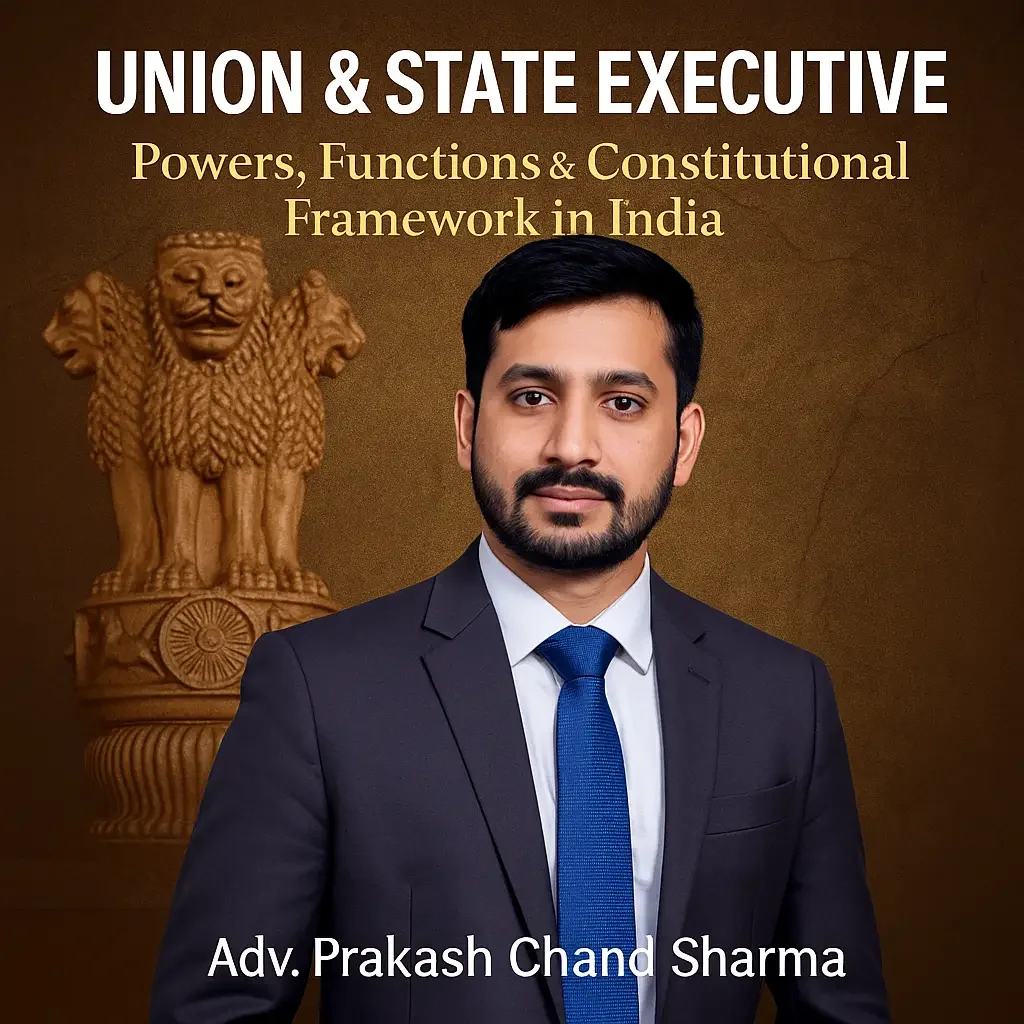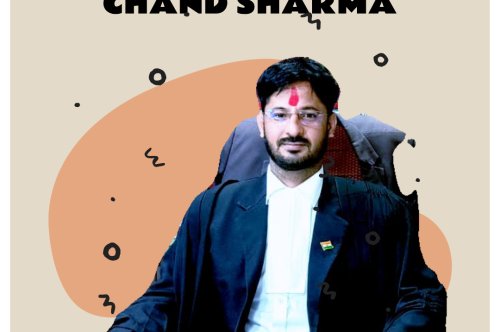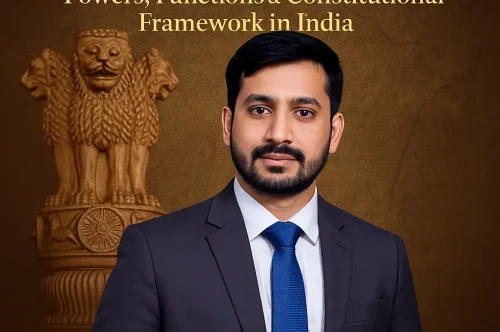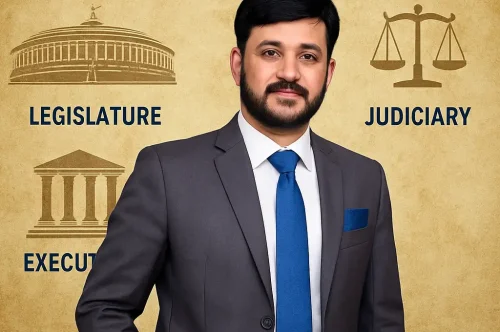Union & State Executive Powers Explained | Adv. Prakash Sharma

Union & State Executive: Powers, Functions & Constitutional Framework in India
By Adv. Prakash Chand Sharma
Chartered Engineer | High Court Advocate | CAO
Founder – Zumosun Universe, Techlam Legal Solutions, JPSD Taxsun LLP
Powered by: TheLegalCourt.com | TheLegalBank.com
Introduction
The Executive forms the administrative machinery of India. Under the Constitution, the Executive exists at two levels:
-
Union Executive → President, Vice President, Prime Minister, Council of Ministers, Attorney General
-
State Executive → Governor, Chief Minister, Council of Ministers, Advocate General
These authorities implement laws, manage government operations, frame policies, and ensure governance across the nation.
Understanding the powers of the Executive is essential for:
-
Public administration
-
Constitutional law
-
Corporate compliance
-
Governance institutions
-
Legal professionals
-
Policy makers
1. The Union Executive (Articles 52–78)
The Union Executive consists of:
✔ President
✔ Vice President
✔ Prime Minister
✔ Council of Ministers
✔ Attorney General of India
It is the highest administrative authority at the national level.
2. President of India (Articles 52–62)
The President is the Constitutional Head of the Union.
Election:
-
Elected by an electoral college (MPs + MLAs)
-
Indirect election system
-
Proportional representation with single transferable vote
Term:
-
5 years
-
Can be re-elected
-
Minimum age → 35 years
Key Powers of the President
A. Executive Powers
-
Appoints PM, Ministers, Governors, CJI & Judges, CAG, AGI, UPSC Chairman
-
Administers Union Territories
B. Legislative Powers
-
Summon & prorogue Parliament
-
Dissolve Lok Sabha
-
Address joint sessions
-
Promulgate Ordinances (Article 123)
-
Assent to Bills
C. Financial Powers
-
Causes the Budget to be laid before Parliament
-
Money bills introduced only with prior recommendation
D. Judicial Powers
-
Pardoning powers under Article 72:
-
Pardon
-
Reprieve
-
Respite
-
Remission
-
Commutation
-
E. Emergency Powers
The President can declare:
-
National Emergency → Art. 352
-
State Emergency (President’s Rule) → Art. 356
-
Financial Emergency → Art. 360
3. Vice President of India (Articles 63–71)
Role:
-
Second-highest constitutional office
-
Ex-officio Chairman of Rajya Sabha
Election:
-
Elected by MPs of both Houses
Powers:
-
Acts as President in vacancy or absence
-
Presides over Rajya Sabha
-
Maintains order and discipline in the Upper House
4. Prime Minister & Council of Ministers (Articles 74–75)
The Prime Minister is the real executive authority in India.
Key Functions of PM:
-
Leader of the Council of Ministers
-
Head of Government
-
Principal advisor to the President
-
Manages administration and policy
-
Represents India internationally
-
Supervises ministries
Council of Ministers:
-
Responsible collectively to Lok Sabha
-
Cabinet Ministers handle key portfolios
-
Ministers of State assist them
Constitutional Principle:
The President acts on the aid and advice of the Council of Ministers headed by the PM.
This ensures democratic executive functioning.
5. Attorney General of India (Article 76)
Role:
-
Highest law officer of India
-
Legal advisor to the Government of India
Functions:
-
Represents government in Supreme Court
-
Can participate in Parliament (no voting rights)
6. The State Executive (Articles 153–167)
The State Executive consists of:
-
Governor
-
Chief Minister
-
Council of Ministers
-
Advocate General
7. Governor (Articles 153–162)
The Governor is the constitutional head of the State, appointed by the President.
Powers of the Governor
A. Executive Powers
-
Appoints CM & Ministers
-
Appoints State Advocate General
-
Controls state administration
B. Legislative Powers
-
Summon/prorogue State Legislature
-
Ordinance power (Art. 213)
-
Assent to Bills (can reserve for President)
C. Judicial Powers
-
Pardoning powers for state offences
D. Discretionary Powers
Governor may act without ministerial advice in:
-
Hung assembly
-
Reservation of Bills
-
Removing or appointing CM
-
Reporting constitutional breakdown
8. Chief Minister & State Council of Ministers
The Chief Minister is the real executive head of the State.
Key Functions of CM:
-
Leads the Council of Ministers
-
Advises Governor
-
Manages state departments
-
Coordinates centre-state relations
-
Supervises state administration
The Council of Ministers is collectively responsible to the State Legislative Assembly.
9. Advocate General (Article 165)
-
Chief law officer of the State
-
Advises Government of State
-
Can appear in State High Court
-
Can participate in legislation (no vote)
10. Difference Between Union & State Executive
| Feature | Union Executive | State Executive |
|---|---|---|
| Head | President | Governor |
| Real Authority | Prime Minister | Chief Minister |
| Law Officer | Attorney General | Advocate General |
| Emergency Role | Central control | Limited |
Conclusion
The Union and State Executive structures form the administrative backbone of India’s governance. While the President and Governor serve as constitutional heads, the real executive authority lies with the Prime Minister and Chief Ministers. The harmonious functioning of these offices ensures administrative stability, policy implementation, and democratic accountability.
Understanding the powers, limitations, and constitutional roles of the Executive is vital for legal professionals, public bodies, corporate entities, and institutions operating in India.
Author
Adv. Prakash Chand Sharma
Chartered Engineer | High Court Advocate | CAO
Founder – Zumosun Universe, Techlam Legal Solutions, JPSD Taxsun LLP
Powered by: TheLegalCourt.com | TheLegalBank.com







